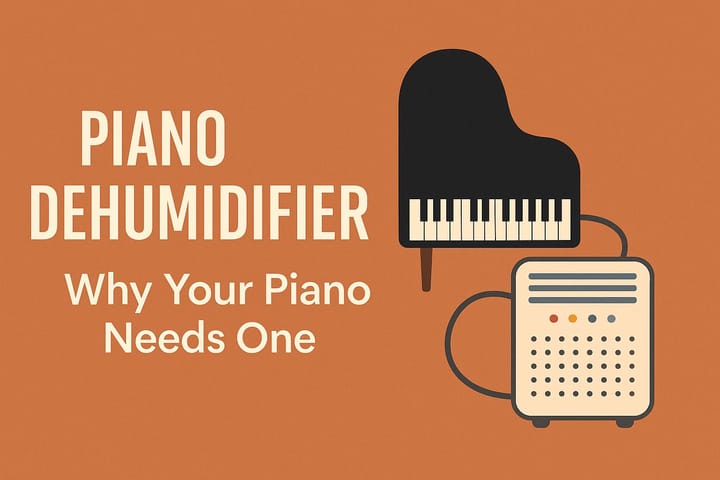Learn the essential steps to clean, protect, and prolong the life of your piano, from a professional concert pianist who treats her instrument like family.
I remember the first time I laid eyes on my Steinway, a gleaming ebony grand piano that seemed to stretch for miles across the concert hall stage. The rich, resonant sound it produced was like nothing I had ever heard before. It was love at first sight, and the beginning of a lifelong partnership.
But like any relationship, it required care and attention. Over the years, I've learned that a well-maintained piano is not just an instrument; it's an investment, a companion, and a source of endless inspiration. The way you care for your piano will directly impact its sound, longevity, and ultimately, the joy you derive from playing it.
Whether you're a seasoned concert pianist or a budding enthusiast, taking care of your piano is essential. A well-maintained piano not only sounds better, but it also holds its value over time. Just as a singer warms up their vocal cords or a dancer stretches their muscles, a pianist must care for their instrument to ensure optimal performance.
In this guide, I'll share the knowledge I've gained from years of experience caring for my own beloved instrument. We'll cover everything from cleaning and polishing the exterior to maintaining the delicate inner workings. We'll discuss the importance of environmental factors like humidity and temperature, and delve into regular maintenance tasks like tuning and voicing.
By the end of this article, you'll have a comprehensive understanding of how to keep your piano in top condition, ensuring that it continues to bring you joy for years to come.
Cleaning Your Piano's Exterior
Just like a concert hall stage, your piano's exterior deserves regular attention to keep it looking and sounding its best. Dust, fingerprints, and even the natural oils from your hands can accumulate over time, affecting both the appearance and the mechanics of your instrument.
The Importance of Regular Cleaning
Dust and debris aren't just unsightly; they can find their way into the piano's action, leading to sticking keys or sluggish movement. Regularly cleaning your piano's exterior can prevent these issues and keep your instrument playing smoothly.
Tools and Materials
Before you begin, gather the following supplies:
- Microfiber cloths: These soft cloths won't scratch the finish and are great for picking up dust and fingerprints.
- Soft brushes: A small, soft-bristled brush can help reach crevices and remove debris from between the keys.
- Mild soap: Choose a gentle, pH-neutral soap specifically designed for wood or high-gloss surfaces.
- Distilled water: Tap water can leave mineral deposits, so use distilled water for a streak-free shine.
Cleaning the Case
The method for cleaning the case will depend on the type of finish:
- High-gloss finish: Dampen a microfiber cloth with distilled water and gently wipe the surface. If needed, add a small amount of mild soap to the cloth, but be sure to rinse it thoroughly afterward. Always wipe in the direction of the wood grain to avoid scratches.
- Satin finish: Use a dry microfiber cloth for regular dusting. If there are smudges or fingerprints, dampen the cloth slightly with distilled water and wipe gently.
- Other finishes: If you're unsure about the type of finish, consult your piano's manufacturer or a piano technician for specific cleaning instructions.
Cleaning the Keys
The keys can be a magnet for dirt and grime, especially if you play frequently. To clean them:
- Use a soft brush to gently remove any loose debris.
- Dampen a microfiber cloth with distilled water and wring out any excess moisture.
- Wipe each key individually, working from the back of the keyboard to the front.
- Dry the keys immediately with a clean, dry cloth.
Cleaning the Pedals
The pedals are often overlooked, but they can accumulate dirt and dust just like any other part of the piano. To clean them, simply dampen a microfiber cloth with distilled water and wipe them down.
Special Considerations for Antique Pianos
Antique pianos may have delicate finishes that require extra care. Avoid using any harsh chemicals or abrasive materials, and always test any cleaning product on an inconspicuous area first. If you're unsure about how to clean your antique piano, consult a professional piano technician.
Cleaning Your Piano's Interior
While the exterior of your piano is relatively easy to clean, the interior is a different story. It's a complex machine with delicate parts that require specialized knowledge and care.
A Cautionary Note
I cannot stress this enough: unless you are a trained piano technician, do not attempt to open your piano or clean its internal components yourself. Doing so could void your warranty and potentially damage your instrument. However, there are a few things you can do to keep the interior clean without venturing inside.
Dusting the Soundboard
The soundboard is the large, wooden panel that amplifies the vibrations of the strings, producing the piano's rich tone. Dust can accumulate on the soundboard over time, potentially affecting the sound quality.
To dust the soundboard, you can use a soft-bristled brush or a vacuum cleaner with a brush attachment. If you choose to use a vacuum, be extremely careful not to touch the strings or any other delicate parts. Hold the vacuum a few inches away from the soundboard and use gentle strokes to remove the dust.
Cleaning the Strings
While it's not necessary to clean the strings regularly, you can occasionally wipe them down with a soft, dry cloth to remove any accumulated dust. Again, be very gentle and avoid applying any pressure to the strings.
Checking the Action
The action is the mechanism that transfers the motion of the keys to the hammers that strike the strings. You can visually inspect the action for any signs of wear and tear, such as broken or worn felt, loose parts, or excessive dust buildup. If you notice any issues, contact a piano technician to have the action serviced.
When to Call a Professional
While you can do some basic cleaning yourself, it's important to have your piano serviced by a qualified technician on a regular basis. A technician will not only clean the interior of your piano, but they will also tune it, regulate the action, and voice the hammers to ensure optimal performance.
Maintaining Your Piano's Environment
Think of your piano like a living, breathing organism—it thrives in certain conditions and wilts in others. Just as a concert hall is meticulously climate-controlled, so too should your piano's environment be carefully managed.

Humidity Control: The Key to a Happy Piano
The most critical environmental factor for a piano is humidity. Wood, the primary material of a piano, expands and contracts in response to changes in humidity. Too much moisture can cause the wood to swell, leading to sticking keys, sluggish action, and even cracks in the soundboard. Too little moisture can cause the wood to shrink, resulting in loose tuning pins, rattling keys, and a brittle tone.
The ideal humidity range for a piano is between 40-50%. To maintain this level, you'll likely need a humidifier during the dry winter months and a dehumidifier in the humid summer months. Invest in a hygrometer to monitor the humidity levels in the room where your piano is located.
Temperature Control
While not as critical as humidity, temperature fluctuations can also affect your piano. Sudden changes in temperature can cause the wood to expand and contract rapidly, leading to tuning instability. Aim to keep your piano in a room with a consistent temperature, ideally between 68-72 degrees Fahrenheit or 20-23 degrees Celsius.
Placement
Where you place your piano within a room can significantly impact its well-being. Avoid placing it near windows, vents, or exterior walls, as these areas are prone to temperature fluctuations and drafts. Additionally, keep your piano away from direct sunlight, as the UV rays can fade the finish.
Pest Control
Pianos can be susceptible to damage from pests like moths and rodents. Moths are attracted to the felt in the action, while rodents may gnaw on the wood or wiring. To prevent infestations, keep your piano clean and free of food crumbs, and consider using mothballs or other deterrents if necessary.
Covering the Piano
When not in use, cover your piano with a breathable fabric cover. This will help protect it from dust, sunlight, and accidental spills. Avoid using plastic covers, as they can trap moisture and damage the finish.
Regular Maintenance Tasks
Even with meticulous cleaning and a well-controlled environment, your piano will still require regular professional maintenance to perform at its peak. Think of it like taking your prized sports car in for regular tune-ups—it's an investment that pays off in the long run.

Tuning: The Heartbeat of Your Piano
Tuning is the process of adjusting the tension of the piano's strings so that they produce the correct pitches. Over time, the strings naturally stretch and loosen, causing the piano to go out of tune. How often you need to tune your piano depends on several factors, including how often you play it, the climate, and the age of the instrument.
Most pianos should be tuned at least twice a year, but if you play frequently or live in an area with fluctuating temperatures or humidity, you may need to tune it more often. Signs that your piano needs tuning include notes that sound sharp or flat, uneven tones between notes, and a general lack of clarity in the sound.
Regulation
Regulation is the process of adjusting the many mechanical parts of the piano's action to ensure that they work together smoothly and efficiently. A well-regulated action will respond to your touch with precision and sensitivity, allowing you to express yourself musically with greater ease.
Over time, the felt, leather, and wood components of the action can wear down or become misaligned, leading to unevenness in the touch, sticking keys, or other problems. A piano technician can adjust the action to restore its responsiveness and ensure that your piano plays like new.
Voicing
Voicing is the art of adjusting the tone of your piano by manipulating the hammers that strike the strings. By carefully shaping and needling the felt on the hammers, a technician can alter the brightness, warmth, and overall character of the sound.
Voicing is a highly subjective process, as each pianist has their own preferences for tone. A skilled technician can work with you to create a sound that suits your individual playing style and musical tastes.
Cleaning the Piano Bench
While not technically part of the piano itself, your piano bench is an essential accessory that deserves regular care. Wipe down the bench with a damp cloth to remove dust and dirt, and condition the leather or wood to prevent it from drying out and cracking.
Regular maintenance is an investment in the longevity and enjoyment of your piano. By staying on top of tuning, regulation, and voicing, you'll ensure that your instrument continues to inspire and delight you for years to come.
Bottom Line
As a concert pianist, my piano is more than just an instrument-it's my voice, my passion, and my livelihood. And just as I wouldn't neglect my own well-being, I make sure to give my piano the care it deserves. By following the steps outlined in this guide, you can ensure that your piano stays in optimal condition, rewarding you with years of beautiful music and cherished memories.
Remember, a well-maintained piano not only sounds better, but also holds its value over time. So take the time to clean, protect and care for your instrument. It will reward you with a lifetime of musical enjoyment. And don't hesitate to seek the help of a qualified piano technician for regular maintenance and any problems that may arise. After all, a piano is an investment worth protecting.





Comments ()